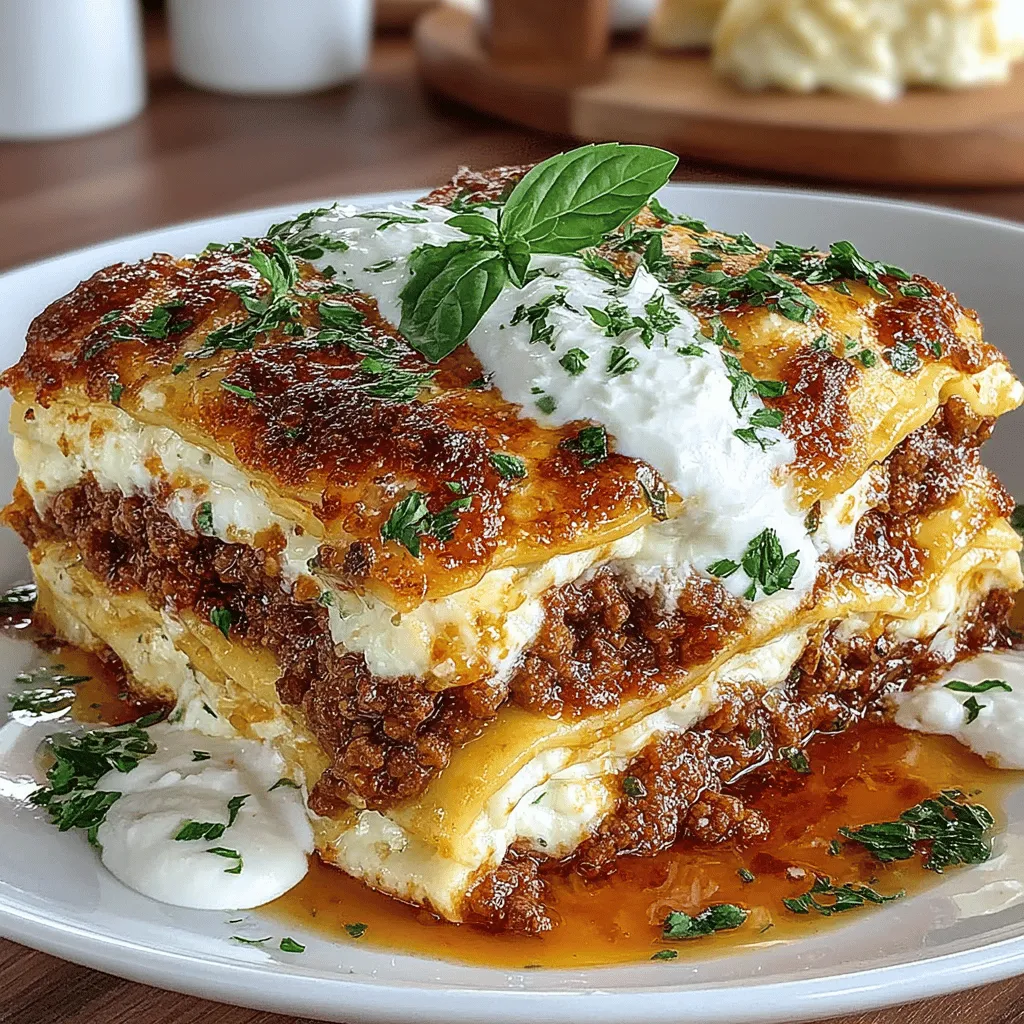Heavenly Layers of Lasagna: A Comfort Food Classic
Lasagna is more than just a dish; it’s a culinary experience that brings warmth and comfort to dinner tables around the globe. This Italian classic, with its rich layers of pasta, savory meat sauce, creamy ricotta, and gooey mozzarella, has secured its place as a favorite for family gatherings and special occasions. The appeal of lasagna lies not only in its delightful flavors and textures but also in its ability to bring people together. Whether it’s a Sunday family dinner, a potluck with friends, or a cozy night in, lasagna is a dish that embodies the essence of home-cooked comfort food.
In this article, we will delve into the essential components of crafting a perfect lasagna, uncovering tips for preparation and baking that can elevate your dish from good to heavenly. Each layer contributes to the overall experience, and understanding these components is key to mastering this beloved recipe.
Understanding the Ingredients
The foundation of any great lasagna is its ingredients. The care you take in selecting and preparing each component will significantly impact the final result. Here’s a closer look at what makes each ingredient essential for creating a mouthwatering lasagna.
Lasagna Noodles
Lasagna noodles are the backbone of the dish, and choosing the right type can make a significant difference in both preparation time and final texture. There are two main types of lasagna noodles: traditional boiled noodles and no-boil noodles.
Traditional lasagna noodles require pre-cooking in boiling water before layering, which allows for a more tender and pliable texture. However, this step can be time-consuming and may deter some home cooks. On the other hand, no-boil noodles have gained popularity for their convenience. These noodles are designed to soften during baking, significantly reducing prep time. They absorb moisture from the sauce as the lasagna cooks, resulting in a perfectly cooked dish without the extra step of boiling.
For those looking to save time, no-boil noodles present a practical option, but traditional noodles can offer a more authentic texture. Ultimately, your choice will depend on your cooking style and time constraints.
Meat Choices
The meat sauce is a crucial element that adds depth and heartiness to the lasagna. While many recipes call for ground beef, there’s a growing trend to blend ground beef and pork. This combination provides a richer flavor profile, as the pork adds a subtle sweetness and fat content that enhances the overall taste of the sauce.
When selecting meat, it’s essential to choose high-quality options to ensure the best flavor. Look for fresh ground meat from a reputable butcher or grocery store. Additionally, consider the fat content; a mixture with a higher fat percentage will yield a juicier sauce. Whether you opt for ground beef, a beef-pork blend, or even a vegetarian alternative, make sure to brown the meat thoroughly to develop a robust flavor before adding it to your sauce.
The Role of Aromatics
No great sauce is complete without the aromatic base of diced onions and minced garlic. These ingredients are essential for building flavor right from the start. Sautéing onions until they become translucent and fragrant creates a sweet foundation, while garlic adds a depth of flavor that elevates the entire dish.
To achieve the best results, use a medium heat to allow the aromatics to soften without burning. Start by adding a bit of olive oil to your pan and then gradually introduce the onions, stirring frequently. Once the onions are soft and golden, add the minced garlic and sauté for an additional minute or so until its pungent aroma fills the kitchen. This careful preparation of aromatics is a crucial step in crafting a delicious meat sauce.
Tomato Ingredients
The tomato sauce is the heart of lasagna, providing acidity and balance to the richness of the cheese and meat. When it comes to the type of tomatoes to use, you have a few options: crushed tomatoes, diced tomatoes, and tomato paste. Each serves a distinct purpose in building the sauce’s flavor and texture.
Crushed tomatoes are often preferred for their smooth consistency and robust flavor, while tomato paste can add a concentrated sweetness and depth to the sauce. Fresh tomatoes can also be used, but they require additional preparation and may not yield the same intensity of flavor as canned varieties.
Incorporating herbs such as basil and oregano can elevate your sauce, infusing it with aromatic notes that complement the tomatoes beautifully. Be sure to let your sauce simmer for an adequate amount of time. This allows the flavors to meld together, creating a harmonious blend that will make your lasagna truly memorable.
Cheese Selection
The cheese in lasagna is not just a garnish; it’s a vital layer that contributes to the dish’s overall richness and creaminess. The classic trio of ricotta, mozzarella, and Parmesan cheese each plays a unique role in achieving the perfect balance of flavors and textures.
Ricotta cheese is often used to create a creamy filling that binds the layers together. Its mild flavor allows it to absorb and enhance the other ingredients, particularly when combined with egg and fresh herbs. Mozzarella, with its gooey meltability, provides that quintessential cheesy stretch that makes lasagna so irresistible. Finally, Parmesan cheese adds a salty, nutty element that rounds out the flavors and creates a beautiful golden crust on top.
When selecting cheese, opt for high-quality options. Freshly grated cheese will always yield better flavor and texture compared to pre-shredded varieties, which often contain anti-caking agents that can affect melting.
Preparing the Meat Sauce
Now that we’ve covered the essential ingredients, it’s time to dive into the preparation of the meat sauce, which is the heart of your lasagna. Here’s a step-by-step guide to creating a flavorful meat sauce that will elevate your dish.
1. Brown the Meat: Begin by heating a large skillet over medium heat. Add a tablespoon of olive oil and let it warm up before adding your ground meat. Use a wooden spoon to break the meat into small pieces, ensuring even cooking. Allow it to brown thoroughly, which typically takes about 5-7 minutes.
2. Add Aromatics: Once the meat is browned, add the diced onions to the skillet. Sauté for about 3-4 minutes until the onions are soft and translucent. Then, add the minced garlic and continue to cook for an additional minute, stirring frequently to prevent burning.
3. Incorporate Tomato Ingredients: Next, add the crushed tomatoes and a couple of tablespoons of tomato paste to the skillet. Stir well to combine all the ingredients. If you’re using fresh herbs, this is the time to add them as well.
4. Season and Simmer: Season your sauce with salt, pepper, and dried herbs like oregano and basil. Bring the sauce to a gentle simmer, then reduce the heat to low. Let it simmer uncovered for at least 30 minutes, stirring occasionally. This simmering time is crucial, as it allows the flavors to develop and intensify.
5. Taste and Adjust: After simmering, taste your sauce and adjust the seasoning as needed. A touch of sugar can help balance acidity, while additional herbs can enhance the flavor profile.
By following these steps, you’ll create a rich and flavorful meat sauce that will be the perfect foundation for your heavenly layers of lasagna.

Creating the Ricotta Mixture
To craft the perfect lasagna, the ricotta mixture is key. Start by combining 15 ounces of ricotta cheese in a mixing bowl. To this, add one large egg, which acts as a binding agent, ensuring that the filling holds together beautifully when baked. The egg not only binds but also enriches the mixture, contributing to its creamy texture and flavor. For added taste, mix in 1/2 cup of grated Parmesan cheese and a pinch of salt and pepper.
To achieve a smooth and creamy texture, it’s essential to thoroughly blend the mixture. You can use a fork or a hand mixer to whip the ingredients together until they are well incorporated and free of lumps. This step is crucial because a smooth ricotta mixture will meld seamlessly with the other layers, enhancing the overall mouthfeel of your lasagna. If you desire a hint of freshness, consider adding a tablespoon of chopped fresh parsley or basil into the mixture.
Assembling the Lasagna
Now that you have your ricotta mixture ready, it’s time to assemble the lasagna. Start by preheating your oven to 375°F (190°C). In a 9×13-inch baking dish, spread a thin layer of your prepared meat sauce on the bottom. This helps prevent the noodles from sticking.
Begin layering your ingredients: place three lasagna noodles over the sauce. Spread half of the ricotta mixture over the noodles, ensuring it covers them evenly. Follow this by adding a generous layer of meat sauce, then sprinkle a layer of shredded mozzarella cheese over the sauce. Repeat this process, creating layers of noodles, ricotta, meat sauce, and mozzarella until all ingredients are used, making sure to end with a layer of noodles topped with meat sauce and a final generous sprinkle of mozzarella and Parmesan cheese.
When layering, aim for an even balance. Each layer should be substantial enough to contribute flavor but not so thick that the lasagna becomes unwieldy. A well-assembled lasagna allows each bite to deliver a perfect balance of flavors and textures.
Baking to Perfection
Once your lasagna is assembled, cover the baking dish with aluminum foil. This step is crucial as it helps trap moisture within the dish, preventing the top from burning while allowing the noodles to cook through. Bake in the preheated oven for 25 minutes.
After 25 minutes, carefully remove the foil to allow the cheese to brown and bubble. Return the lasagna to the oven and bake uncovered for an additional 15-20 minutes or until the top is a beautiful golden brown and the edges are bubbling. This final uncovered baking step is essential for achieving that classic lasagna look and texture.
Cooling and Serving
After baking, it’s tempting to dive right in, but it’s critical to let the lasagna cool for at least 15-20 minutes before slicing. This cooling period allows the layers to set, making it easier to cut and serve neat portions. If you cut into the lasagna immediately, the layers might slide apart, resulting in a messy presentation.
When ready to serve, use a sharp knife to cut into squares or rectangles, and then gently lift out each piece with a spatula. This method helps maintain the integrity of the layers, showcasing the beautiful construction of your dish.
Garnishing for Presentation
To elevate the presentation of your lasagna, consider garnishing it with fresh basil leaves or a sprinkle of chopped parsley. Not only does this add a pop of color, but it also introduces a fresh flavor that complements the richness of the dish. Arrange a few basil leaves on top just before serving for a lovely decorative touch. This small detail can transform your lasagna from a comforting meal into an impressive centerpiece for any dining table.
Nutritional Overview
Lasagna can be a hearty dish, but understanding its nutritional aspects is important for maintaining a balanced diet. A typical serving of traditional meat lasagna contains around 400-500 calories, depending on the ingredients and portion size. It provides protein from the meat and cheese, carbohydrates from the pasta, and fats from the cheese and oils.
When enjoying lasagna, moderation is key. Pairing it with a side salad can help create a more balanced meal while also adding fiber and vitamins. Additionally, consider portion control by serving smaller slices, allowing you to savor the flavors without overindulging.
Variations of Lasagna
Lasagna is incredibly versatile, allowing for various adaptations to suit different dietary preferences. Here are a few popular variations:
– Vegetarian Lasagna: Replace the meat sauce with a medley of vegetables such as zucchini, spinach, mushrooms, and bell peppers. You can also add layers of roasted eggplant or a creamy béchamel sauce for added richness.
– Seafood Lasagna: Incorporate a mix of seafood like shrimp, crab, or scallops with a white sauce or marinara. This variation brings a delightful twist to the traditional recipe.
– Gluten-Free Lasagna: Use gluten-free lasagna noodles made from rice or corn. Additionally, you can layer in thinly sliced vegetables, such as zucchini or sweet potato, as a substitute for noodles.
These variations maintain the essence of lasagna while catering to various taste preferences and dietary restrictions.
Cultural Significance of Lasagna
Lasagna is deeply rooted in Italian cuisine, with a rich history that dates back to ancient times. The earliest known recipes for lasagna can be traced to ancient Greece, where layers of pasta were used in dishes. However, the modern version of lasagna, featuring layers of pasta, meat, and cheese, originated in Italy, particularly in the region of Emilia-Romagna.
Lasagna has evolved over the years, adapting to regional ingredients and preferences. Each Italian household often boasts its own unique recipe, passed down through generations. Today, lasagna is celebrated not just in Italy but around the world, symbolizing comfort, family gatherings, and shared meals.
Conclusion
Lasagna is more than just a meal; it’s a dish that brings people together, filled with layers of love, flavor, and tradition. Whether you’re a seasoned chef or a beginner in the kitchen, this heavenly layers of lasagna recipe is guaranteed to create a satisfying and memorable dining experience. With high-quality ingredients and careful preparation, you can enjoy a classic comfort food that delights the palate and warms the heart. Embrace the joy of making and sharing this beloved dish, and watch as it becomes a cherished part of your culinary repertoire.


